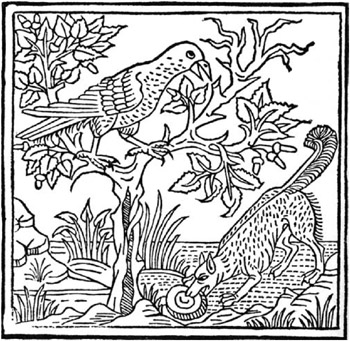Printing
Another significant change in the ability to produce images came about a thousand years ago with the emergence of woodcuts, which were used to print textiles . In the early fifteenth century, the use of woodcuts and wood engraving began to take hold in Europe as a method of producing pictures (see Figure 1.6). At about the same time, Johannes Gutenberg introduced the concept of movable type technology. Printing gave us the capability to produce multiples of the same image ”the first big step in mass communication.

Figure 1.6: A woodcut from a Venetian edition of the fables of Aesop, published in 1491
Of course, the printed image has evolved over the past five hundred years; we ve invented numerous methods of imprinting ink on paper, monochromatically or in full color . In the case of traditional offset printing, the process involves separating colors into their ink components and transferring the information to a piece of film and then to a metal plate. The plate is mounted on a printing press where ink is applied to it. The image is transferred (offset) to a rubber blanket mounted on a cylinder which in turn contacts the paper and imprints the image. The process is repeated for each color component.
Photoshop software is used to prepare images for almost any commercial printing technique, including offset lithography, silk screen, and digital press. Artists even use Photoshop to create and transfer images for traditional copper or zinc intaglio printing.
The most direct method of printing a Photoshop image is to a laser or ink-jet printer, but Photoshop files can also be output to film recorders to generate color slides, to imagesetters to produce high-resolution color separations on film, or directly to the printing plate. Exciting new output technologies have appeared within the last few years to print super- sized ink-jet images and continuous-tone photographic prints.
EAN: 2147483647
Pages: 355